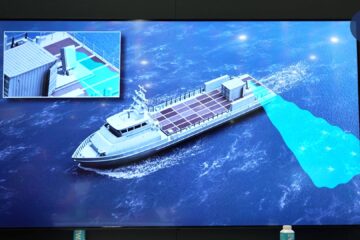Task Force 59’s (TF 59) role in the development and employment of unmanned systems was highlighted throughout Surface Navy Association (SNA) 2023 National Symposium. The 5th Fleet-based manned-unmanned unit has been applying “leading-edge technology and experimentation” in unmanned and artificial intelligence applications for the Navy.
Commander of U.S. Naval Forces Central Command, Vice Admiral Brad Cooper, unveiled that TF 59 is fully operational in his keynote speech covering the unit’s progress and outlook going forward. TF 59 aims to have 100 unmanned vehicles by the summer of this year, with control of the drones fractioned out between the U.S. and its partners in the region. Developments from Exercise Digital Horizon were highlighted by Cooper, particularly the mesh network and improvements in command and control seen during the exercise.

Digital Horizon’s demonstration of a “mesh network,” the deployment of various unmanned systems to create a maritime domain awareness network and feed it back to TF 59’s command centers, was described by the Vice Admiral as “Cooperative Engagement Capability on steroids.” The ability of unmanned systems to expand the coverage of manned assets was also pointed out by Cooper. One example brought up was the pairing of two unmanned surface vessels with a manned vessel, such as a cruiser or destroyer, leading to the creation of a 100-mile-wide radar barrier for that manned asset.

One of the more innovative statements on TF 59 was Cooper’s description of a “single pane of glass” command and control capability. This capability allows for the control of multiple unmanned systems by a single person at the same time, reportedly possible by the application of Artificial Intelligence to help operators manage the control and information received by the unmanned systems. This “rapid innovation” was also seen in the performance of TF 59 in Digital Horizon. From “software changes in hours,” to “hardware changes in days,” the speed and rapid ability of TF 59 to adapt during the exercise exceeded “their wildest expectations.”
The milestones and breakthroughs of TF 59 were also highlighted by Secretary of the Navy Carlos Del Toro at SNA 2023, who stated:
“We are gaining ever greater mastery of unmanned and autonomous systems. Already autonomous systems address some of our most dangerous missions. Soon they’ll be able to take on increasingly more complex missions against my competitors. It is through applying leading-edge technology and experimentation, such as what Task Force 59 is accomplishing in Fifth Fleet, that we are learning how to close our gaps rapidly and sharpen our competitive edge.
The Navy aims to transfer these experiences gained from TF 59 to the rest of the fleet.
“We will take the principles that we’ve learned from Task Force 59 and we will apply them in the Pacific and in Central and South America throughout the 4th Fleet.”
Del Toro also stated his vision of unmanned systems in the fleet in the future:
“Ultimately I envisioned a Navy of unmanned autonomous systems and manned, that will reduce the risk to our personnel and lower operating costs as we protect freedom of navigation and vital areas like the South China Sea.”
Chief of Naval Operations Admiral Mike Gilday gave an overview of the Navy’s ongoing unmanned projects. Gilday touched Unmanned Surface Vessels (USV), the MQ-25 Stingray, and the Orca Extra Large Unmanned Undersea Vehicle (XLUUV).

Gilday doesn’t expect the first USVs to be completely unmanned, as seen with Lockheed Martin’s Optionally Unmanned Surface Vessel (OUSV). He also expects the first deployment of USVs with a Carrier Strike Group to occur by 2027:
“Now, are they going to be unmanned? I’m talking about the larger or medium unmanned vessels. I don’t think they going to be completely unmanned, to begin with. I think that we are on a path to be able to deploy vessels like that [referring to USVs] with a Carrier Strike Group probably by 2027. I think puts us on a path to demonstrate in a meaningful way that we can do manned-unmanned teaming with those vessels, much like we’re doing right now with ships in unmanned in 5th Fleet.”
A brief update on the MQ-25 led into the drone tanker’s role in the development of FA-XX, the US Navy’s next-generation fighter aircraft.
“And that (MQ-25) for us is the pathfinder for next-generation air dominance, and that is a phased program through the late 2020s into the 2030s that we need to deliver both 6th-generation manned and unmanned aircraft.”
The US Navy is expecting another four XLUUVs next year and intends to have the Orcas deploy overseas with a focus on minelaying. Future “classified” capabilities are also being explored.






